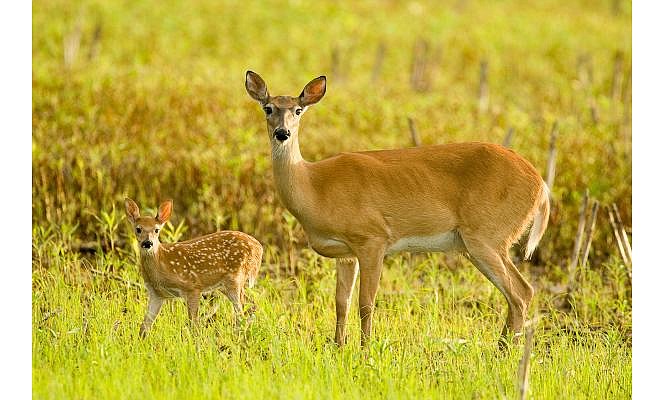Wildlife encounters are always exciting. Whether you stumble upon a nest of baby birds or have to flush troublesome raccoon from your garage attic, close contact with wildlife provides a thrill.
Knowing how to deal with wildlife when encountered is critically important. It could mean life or death for them.
Baby deer and other young animals
Finding a fawn burrowed in tall grass is wonderful, but don't touch it. That fawn has not been abandoned. The mother is nearby feeding, or attempting to steer you clear of her young.
A mother deer leaves a fawn during the day. She ventures off to feed, so her scent doesn't attract predators to the fawn. As a natural precursor to predation, fawns are nearly scentless. People often mistake a fawn as abandoned, when in fact it's common to see fawns by themselves. The mother is properly caring for her young by giving it some distance.
If you mess with the fawn, the mother may not come back. Just leave it alone. The doe will come back to care for the fawn. Picking up a baby animal that is not orphaned or abandoned can harm the animal and takes it out of its natural environment.
Most baby animals are not abandoned. Many animals leave their young alone when searching for food and come back to them throughout the day. They also use this as a way to deter predators because a predator may follow the mother back to its young.
Nuisance wildlife
Raccoons, skunks, opossums, squirrels, beavers, muskrats, minks, long-tailed weasels, foxes, coyotes and other wildlife species can become a nuisance.
Missouri landowners or tenants can trap and release, or kill these animals own property without a permit if they are causing damage, but that's not ideal. Prevention is the key to minimizing nuisance wildlife.
If you do find yourself in conflict with an animal, live traps and relocation are a great choice. You can buy live traps for capturing animals at garden-supply or home-improvement stores. Always be cautious when dealing with wild animals. They are afraid of you and will attack out of fear. Many carry diseases. If you are bit or scratched, let your doctor know.
Releasing wild animals on a city, county or state property may be illegal or require written permission. Contact proper officials before releasing wild animals on public property.
Here are a few tips for limiting nuisance wildlife:
• Pick up dog and cat food at night and keep birdfeeders out of the reach of wild animals or bring in birdfeeders at night.
• Install a commercial chimney cap made of sheet metal and heavy screen. Repair soffits to prevent access to attics, and install strong, metal vent covers.
• Prune tree limbs at least 10 feet away from the roof.
• Buy heavy metal garbage cans with lockable lids; otherwise, keep garbage cans indoors as much as possible.
• Install metal skirting around the bottoms of decks.
• Provide shelter structures for fish in ornamental ponds and water gardens; cover the pond during the night with metal screening.
See you down the trail ...
Brandon Butler is an outdoors columnist for the News Tribune. Contact him at [email protected].

